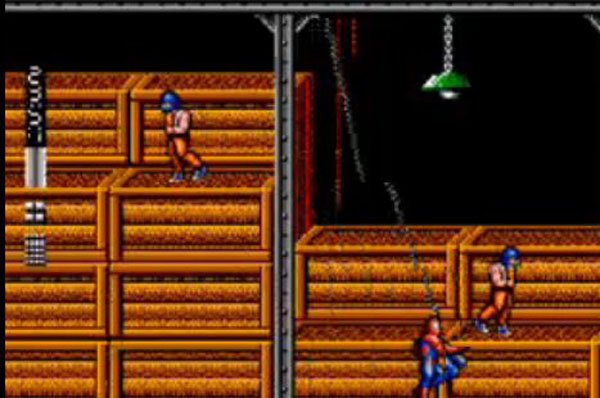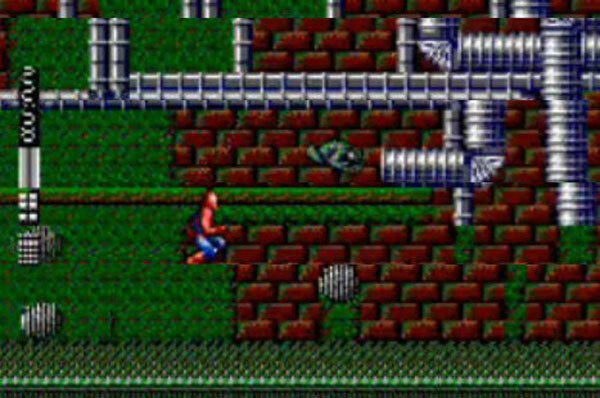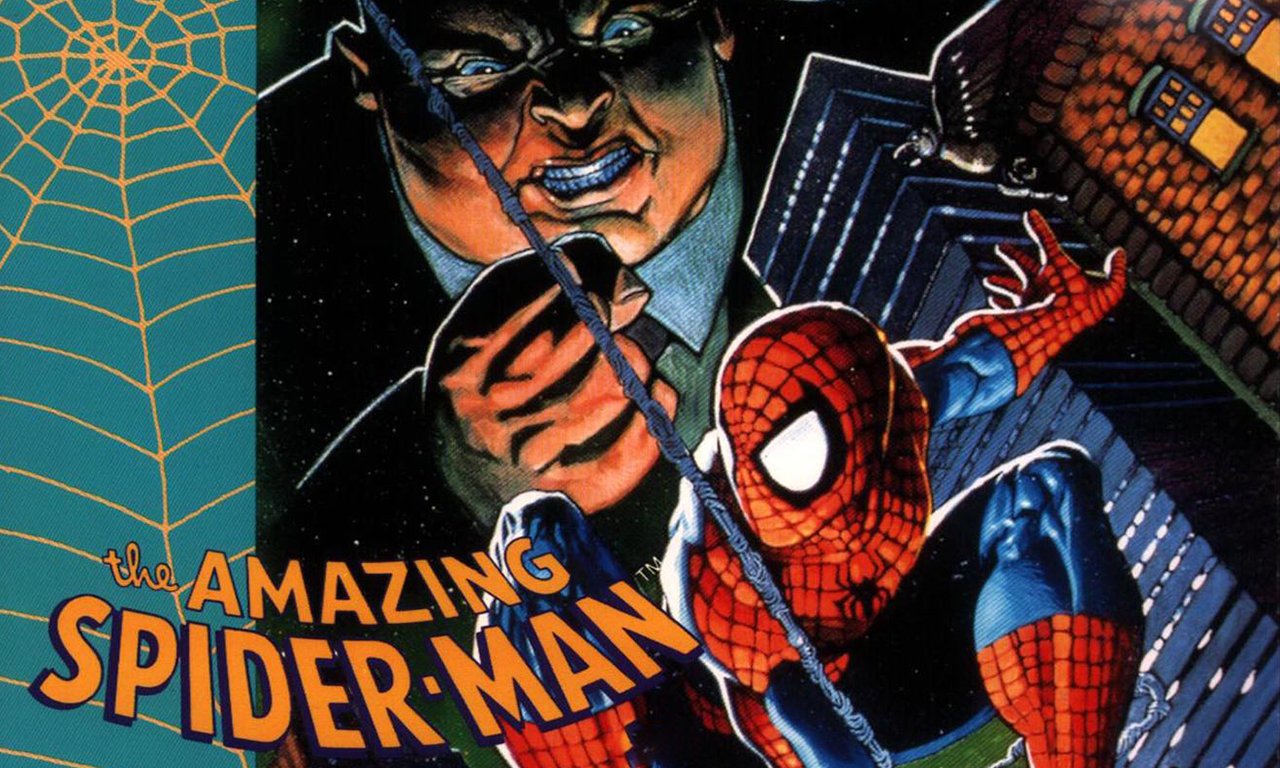Many attempts have been made over the years to bring gamers’ super hero fantasies to life. As a rule, these comic to gaming licensed titles are usually less than well received by fans of the original character. It seems that somewhere in the conversion between mediums something of the character’s essence is lost, that it loses that special spark that everyone loves. As a rule, the games are just lacking something you can’t quite put your finger on. With any rule, however, there are always exceptions and The Amazing Spider-Man vs. The Kingpin for the Sega Master System was nothing if not exceptional.
In a lot of ways, the game looks like something that would shape up to be fairly standard comic book to gaming fare. The storyline follows a fairly simple plot in which the Kingpin has planted a bomb in New York City in order to frame Spider-Man and turn the city against him. He has of course aligned himself with other Spidey hating villains whom Spider-Man must defeat, each in turn to order to acquire all the full set of keys needed to disarm the bomb and save both the city and his reputation. Of course, it also all needs to be done within twenty four hours.
The game does boast an impressive presentation, the music and graphics both hold up quite nicely compared to other Master System releases. In fact, even in an extended play-through the music manages to never get annoying or overly repetitive, which is quite a feat for any 8-Bit game. This could be in part due to how well all of the elements of the presentation has been blended together, despite the somewhat cartoonish, colourful nature of the graphics they do seem to blend quite well with the music to give the game a somewhat bouncy feel.
As slick as the presentation is, however, it’s not what causes the game to continue to stand out amongst the crowd. That honor goes to the most important aspect of any game, the gameplay it’s self. To really understand the brilliance of Spider-man vs. The Kingpin, you first need to know a little something about the Master System. For those of you who are not familiar with the Sega Master System, the SMS is most easily explained as being Sega’s answer to Nintendo’s original NES/Famicom console. An early entrant into the world of 8-Bit gaming. Although there were several important differences between the two systems (which I won’t address here) the two systems did share a few key limitations. One of them of course being the basic control pad and game control schemes allowed by it. For modern gamers it must be difficult to understand just how we ever got by with no more than two buttons and a single directional pad, how we ever found such a clunky looking, non-ergonomic rectangle suitable to gaming. Games of the day were typically based around the simple controls presented by the hardware, one button would be used for attack while the other was jump, for example. Occasionally developers moved beyond this sort of layout and would add additional functionality by differentiating between a press and a hold, such as allowing the player to hold the attack button in order to run more quickly. There are few precious games, however, that don’t just break the mold set by these simple controls, but absolutely shatter it.
When you first slap Spider-Man vs. The Kingpin into your Master System, you may expect to find a Spidey that can run and jump, or even possibly alternate between punches and kicks depending on the situation, but little else. Once you start to play however, you’ll discover that in this game, he really does do whatever a spider can. The game allows you to cling to walls and scurry about, you can punch, sling web, swing around freely, climb a single strand of web and just about anything else you’d expect Spider-Man to be able to do. Most amazingly, you can do it all smoothly and fluidly with nothing more than the simple two button configuration of the Master System controls. The controls go well beyond the usual “hold to run” paradigm, using a scheme that actually differentiates between actions such as holding or tapping a directional button to change functionality. It actually allows for several different actions controlled by a single button based on the character’s location or previous action.

Paul Hutchinson, the game’s one and only programmer was kind enough to take a few moments to explain how this control system came to be,
“The control scheme for the SMS version of Spider-Man Vs. The Kingpin evolved through trying various combinations of buttons and actions until the result was something that felt natural. Actions were added one at a time expanding on the previous set of actions with each build of the game during development. I worked closely with Ed, the project manager, on the development of the control scheme. He would give suggestions, and feedback from the play-testing group. I would implement things as best as I could given the constraints of the controller we had to work with. We wanted to make Spider-Man able to do as much as possible with as intuitive a control system as possible.”
Amazingly, he seems to have had relatively little trouble coding this elaborate system,
“The coding for the control scheme was fairly straight forward. Whatever current state Spider-Man was in determined what the various combinations of buttons would do. Standing, crouching, walking, jumping, crawling, swinging, falling or ‘hit’ were states Spider-Man could be in so the code would check for this and then compare the button states for valid actions that Spider-Man could take in that state. The code contains a lot of ‘CP n’ and ‘JR NZ, label’ statements that achieve this. The amount of actions Spider-Man could do was also limited by the amount of sprites we had available to display them. We crammed in as many actions as we could given this constraint.”
As important as this interesting control scheme was to the over all game, it needs to be said that the controls are only part of a package that needed to come together to form this title’s fantastic gameplay experience. Allowing Spider-Man his full repertoire of abilities would have done little good if the game didn’t provide the player with that something special, with the essence of what makes the character who and what they are. With a character like Spider-Man, that essence boils down to the web-slinger’s speed and agility, something not easily translated into the 8-Bit world. Even so, Spider-Man vs. The Kingpin provided this sense in a way no other Spider-man title would for years to come, if ever. The rapidity with which the player can switch between actions is incredible, the smoothness and fluidity of jumping, clinging to the wall, jumping again to swing on a web to land on the other side of your foe and start hammering him with wads of webbing, it’s nothing short of awe inspiring. It all happens so quickly, so smoothly.
According to Paul, achieving this feeling of speed and agility was the primary goal of development,
“We wanted to create a Spider-Man game worthy of the main character. Ed and I worked well together to hone the feel of the game to just where we wanted it to be. We wanted to get as much agility out of the character as we could possibly achieve on the SMS. I think we did a pretty good job of that over all. The way I work is to be on the conservative side of what I am able to achieve with code. Ed would ask ‚”Hey, Paul… could you make Spider-Man do this?”. I would respond with , “Oh, I am not so sure about that, Ed.‚” And then I would promptly
get to work on writing the code that achieved what Ed had asked for. I surprised myself, and Ed, on several occasions by what I was able to code.”
Paul was also kind enough to explain a little bit about how he managed to squeeze this performance out of the SMS,

“One trick I remember with the sprites was to run through the list of things that needed to be displayed forwards and then backwards, alternating frame to frame. So the limitation on the number of sprites on a given line would be less of a problem. There may be a little flickering noticeable, but things would not just simply disappear. If possible, and where necessary, characters would be used instead of sprites. This was necessary for Dr. Octopus. His arms were too long to be displayed using sprites.”
“As I had learned on the ZX-Spectrum I made good use of coding out long to save on valuable T-States. Especially during the vertical blank interrupt, where all the sprite and screen data had to be loaded and updated. One routine had 64 OUTI instructions one after the other to output 64 bytes of data, as opposed to OTIR, which would do that in one instruction. OUTI takes 16T whereas OTIR takes 21T except for the final byte which takes 16T. So, at 5T per byte, I saved 315T with that one routine every time it got called (which was a lot). ‚ÄúProgramming
The Z80” by Rodnay Zaks was a constant reference for finding out where those valuable T-States could be saved. LDI was used in a similar manner instead of LDIR for loading blocks of memory. I had to get a lot of data shifted during the VBI when nothing is being displayed as the raster scan has finished the bottom of the display and is returning to the top to start over again. Better to use up more memory
than to write tighter code when speed is of the essence.”
It’s interesting, looking at the game today, to see how either one of these two feats of engineering could have been completely wasted had the other not worked out so well. All of the speed and fluidity of animation would have been a waste of time and effort without the accuracy and precision of the controls. Without the numerous abilities presented to the player the game would have just been just another jump and punch release. Similarly, the ingenious nature of the controls would have never really been noticed if the gameplay was slow or choppy, if it gave you any sense of a slow or clunky Spider-Man. As it stands, the game still shows just how fun a game can be when everything comes together just so.
With the similarities in architecture between the original Master System and the Sega GameGear, it’s not especially surprising that after Spider-Man vs The Kingpin’s successful release on the Master System that a port to the GameGear quickly followed. The interesting thing about this port, however, is that between the similarity of the GameGear and Master System and the fact that Paul himself was tasked with this porting of the game, the two releases remain nearly identical. Which is good news for anyone looking to pick up a copy of the game, as GameGear releases do tend to be easier to find in North America.
Regardless of which release of the game you do happen to pick up, while you’re slinging web and crawling walls, it’s hard to believe that the game is now roughly twenty years old. I asked Paul how he felt about the game and his work on it after all these years.
“Looking back on Spider-Man for the SMS I am proud that with that title I proved that I could write for machines other than the ZX-Spectrum and Amstrad CPC. And that I could write titles that were of a quality that made them commercially lucrative for the company that published them. I also thoroughly enjoyed working with my project manager, Ed; he was a pleasure to work with.”
“I was very pleased with the finished product. The Spider-Man movie did not come out for another 12 years though, so we missed the tie-in for that by a little bit. As a Spider-Man title amongst Spider-Man titles I think it stood up pretty well at the time. And still manages to hold its own as a game over all.”
The game most certainly has stood the test of time, it stands today as an amazing example of what was truly possible in the 8-Bit era and what could be accomplished by skilled developers willing to take the time and care to produce something above and beyond. So whether you’re a hardcore Spider-Man fan, a lover of classic games or just someone looking to whittle away a few hours with a smile on your face, do yourself a favour and give the game a try.



